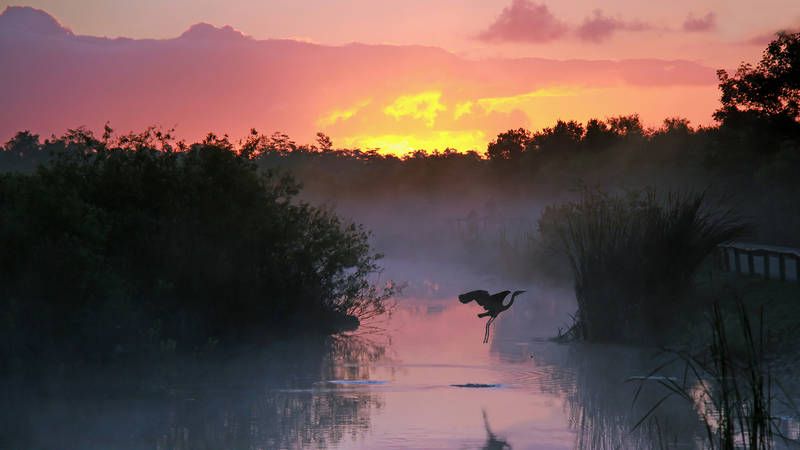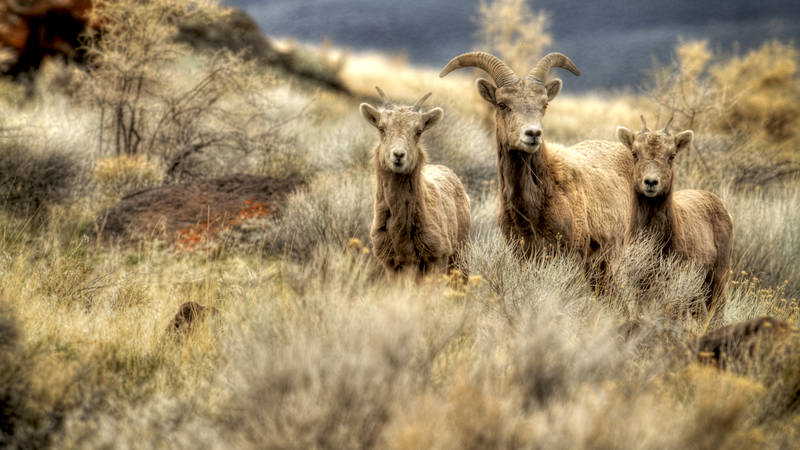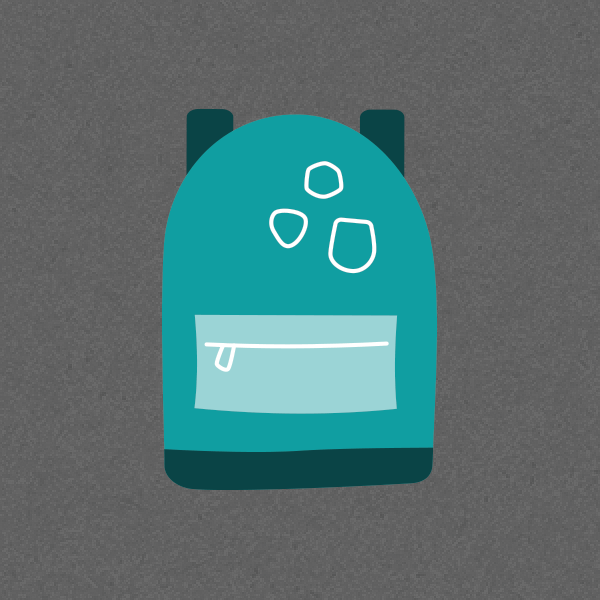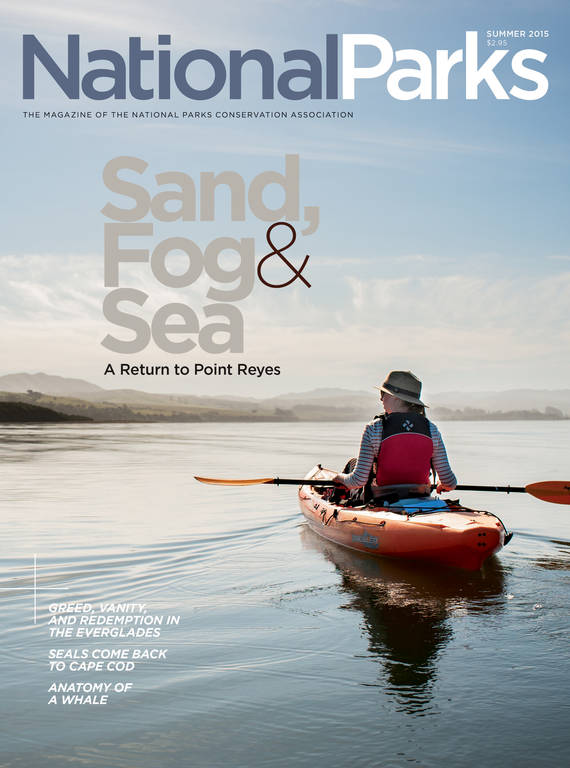Summer 2015
The Price of a Feather
More than a century ago, the discovery of a hidden bird refuge in the Everglades led down a path of greed, vanity, and murder. And that’s just the beginning of the story.
In the fall of 1889, George Elliott Cuthbert was steering his canoe along a lake edge deep in Florida’s Great Mangrove Swamp when he saw a white feather floating on a current. A fisherman and ship captain, he had been canvassing the area for days, watching birds fly between their foraging grounds and a mysterious central locale, toting fish or frogs to feed their nestlings. But where was the hub? Rumors from Seminole traders had enticed him to sail 80 miles from his home on Marco Island on the Gulf Coast, then hack, wade, and drag a canoe through the mangrove tangle for days to reach this remote chain of lakes. Assailed by mosquitoes and thick-tongued from a dwindling supply of fresh water, he almost gave up. Until he saw the feather.
Cuthbert bushwhacked in the direction of the current, which opened to a vast lake. Far ahead, he saw what he came for—“a flower, a beautiful white blossom,” as he told his children. It was a 2-acre islet of mangroves, so thickly dotted with nesting birds and newborns—thousands of great and snowy egrets, ibises, wood storks, tricolored herons, and the odd, circus-colored roseate spoonbill—that it bloomed. He moored his craft on the rookery and hid among the branches.
Then he raised his rifle and shot the adults at close range. He scalped a tuft of feathers off each of their backs. The chicks were left alone, to starve.
Cuthbert was chiefly after the egrets’ nuptial head plumage, called aigrettes in the fashion press. At the turn of the century, these unique, otherworldly feathers, which grow only during the nesting season, were worth $32 an ounce—double the price of gold. Aigrettes were the most prized feather in the plume trade: the massive market in wild bird plumage that adorned women’s hats. Aigrettes’ loosely spaced barbs render them so filmy that they practically levitate, lending grace to the movements of the woman underneath. This feather’s popularity meant that all of the more accessible egret rookeries had long been depleted. The islet that Cuthbert found was probably the last place in Florida where a super colony of egrets still thrived.

Everglades National Park
One of the largest wetlands in the world, this iconic “River of Grass” protects 1.5 million acres of subtropical wilderness in South Florida.
See more ›One of Cuthbert’s two trips to the rookery netted him $1,800—more than $50,000 in today’s dollars. With the earnings, he purchased half of Marco Island, a schooner, and a houseful of fine furniture. Then Cuthbert gave up plume hunting to farm his land. Cuthbert’s half of the island was sold long ago, and it’s now covered with condos and high-rise resorts and worth almost $5 billion.
George Elliott Cuthbert took plenty away from this secret place, but he gave it two things: its name and its vigorous but short-lived fame. In the decades after Cuthbert’s discovery, this isolated thumbprint of land that is now part of Everglades National Park was sought out, fought over, fought for, lionized, and then forgotten. Today, few people know or care about Cuthbert Rookery. Yet even after a century of protection, its future is still precarious. The rookery remains an enduring symbol of the high-stakes struggle to protect the Everglades from a host of threats.
“Cuthbert Rookery was like finding the lost city of gold,” says Sonny Bass, who was the park’s senior wildlife biologist for 36 years. Its value is rooted in its location. The islet sits along the brackish zone where the saltwater of Florida Bay meets Everglades freshwater flowing from the north. This estuary, historically one of the world’s ecologically richest, yields a bounty of the small fish that wading birds eat. An island in that estuary, Cuthbert Rookery has a natural moat that has kept the birds safe from critters like raccoons, but other predators were a little more resourceful.
NPCA @WORK
“Cuthbert kept his secret for a long time,” says Bass. “But eventually, other hunters began following him.” The refuge would regain birds after each gunning, only to be “shot out” again and again. “You coulda walked right around the ruke-ry on them birds’ bodies,” reported one local witness after a 1904 cleanout. “Between four and five hundred of ’em.” Once, two hunting parties reportedly turned their rifles on one another, sinking the boats and forcing a wretched slog back to camp through the crocodile-infested thicket.
CHAPMAN’S CRUSADE
By the early 1900s, Cuthbert’s secret had reached the scientific community, and the islet became a touchstone for the dawning conservation movement. Naturalists began making the difficult pilgrimage to the rookery to marvel and raise alarm at the devastation of Florida’s famous waders. “As we approached the island an immense cloud of birds arose, with a mighty roar of wings, and circled about us in a bewildering mass,” wrote one scientist in 1903, noting at least 4,000 nesting birds.
For ornithologist Frank Michler Chapman, the desire to stand inside that charmed circle became a mission. Chapman began his career in 1887—two years before Cuthbert reached the rookery—as a 23-year-old volunteer at the American Museum of Natural History with a talent for mimicking birdsong. In the ensuing decades, his populist passion for birds soared. A prolific author and public speaker, Chapman founded the publication that became Audubon magazine and did more than just about anyone in his day to endear America to its feathered kind.
In 1903, Chapman was pioneering a new kind of exhibit hall—mounted birds displayed in a series of dioramas that replicated real places where they lived. The Hall of North American Birds would be a tool for advocacy as much as science education. As a leader of the growing public crusade against the plume trade, Chapman knew his gallery would stoke emotions over the wildlife left to save.

9 Wildlife Success Stories
National parks provide critical habitat for a variety of animals—in some cases, they are the only places that threatened or endangered species have left to call home.
See more ›Accompanied by artists and preparators, Chapman traveled 65,000 miles to document the continent’s charismatic and imperiled birds for the project. He’d sit still for hours in homemade blinds, observing, communing. However restrained Chapman tended to be among people, his zeal brimmed over when he was among birds. Once, in the Bahamas, he sat, thrilled, on an empty flamingo nest while the pink birds encroached. “I myself seemed to have become a flamingo,” he wrote. The scientist feared that if he didn’t get to the islet soon, he’d find no rookery left to feature.
Yet without rail lines or roads to the heart of the Everglades, the journey was still daunting. To get to the rookery then, visitors sailed up from the Keys across shallow Florida Bay. About a dozen miles from shore, they hit the mud flats, where crews were forced to drag their boat for five hours in knee-deep sludge, soft and sucking as porridge, until they reached the coastal maze of mangroves. Here, the party would paddle and push, portage and chop for seven more miles before reaching the creek to Cuthbert Lake. “It would be suicidal for a stranger to the country to attempt the trip unguided,” said one early visitor.
Chapman tried for Cuthbert’s rookery four times between 1904 and 1907, but each attempt was doomed by misfortune: a shootout, a storm, a fire, and the murder of the first warden that the Audubon Society had hired to protect Cuthbert’s birds. (The embittered plume hunter who shot him was never indicted.)
At last Chapman reached the rookery in 1908. He came ashore under an umbrella draped with green denim, where he hid from two o’clock until dark. At dusk, about 2,000 birds began to sail in for the night. The stench of fish and guano and a chorus of bird babble engulfed the ornithologist. He departed, humbled, with eggs and a nest for his diorama. He left the adults alone.
A MODERN-DAY RECKONING
Chapman’s diorama still sits almost directly above my former office at the American Museum of Natural History, where I worked as a writer after a stint in the fashion industry. Captivated by how the spectacle of nature at Cuthbert Rookery collided with the wants of fashion—its nexus of beauty and death—I found myself increasingly curious about this place. Did the islet still exist? Did it bloom with birds now?
I suspected it might. State and federal legislation that prohibited hunting, shipping, and selling of plume birds was passed in the decade after Chapman’s visit—the nation’s first wildlife-protection laws. By the 1920s, women began abandoning lavishly feathered hats for sleeker fashions. And in 1947, much of South Florida became Everglades National Park. Vital nesting spots like Cuthbert became off-limits to the public. The islet began to slip into obscurity.
WHERE TO WATCH EVERGLADES BIRDS
Today, to go to Cuthbert Rookery, the main hardship is finding one of the few people who knows it exists—and has a permit—to take you there. I call a local guide, who just then was walking into the Florida Audubon research office on the Keys to meet biologist Pete Frezza. Frezza agrees on the spot. “Shoot, yeah,” he tells me later, when I ask if this place is special to him. “It’s Cuthbert. It’s the last great rookery.”
The journey today bears little resemblance to the one Cuthbert and Chapman faced; there’s even a paved parking lot off the boat launch. Still, outboard motors are prohibited in the area, so most of the way, Frezza has to propel our boat through the shallow water by pushing a long pole against the mucky bottom.
It takes hours. En route, we weave through two narrow creeks flanked tightly with mangroves, their roots chopped to allow passage. In the creek to Cuthbert Lake—the one I imagined my predecessors came through—an old “Do Not Enter” sign trails in the water. When we spot the green smudge of the rookery, about a mile away, I’m surprised by how small it is. Frezza tells me that several hurricanes have battered it to half its former size. Like the diorama, it is flecked with white dots.
When we approach, the dots burst to life. Birds start squawking and flapping above their nests—“flushing,” Frezza calls it. It’s what flocks do when they’re frightened. A crow that followed us darts ahead to plunder eggs and young, worsening the alarm. As we circle the islet from a safe distance, the birds’ anxiety peaks, and so does mine.
Eventually the crow disappears, and we all settle. We tie up to a downed branch about 20 feet away, the boat bobbing gently. I don’t dare ask to go ashore.
Instead, I start counting. Atop the canopy, about 50 wood storks—a threatened species—resume their humped poses, calmly tucking their scaly, saurian necks against white breasts. Lower down, there are four or so anhingas, a few dozen great egrets, and one pair of snowy egrets. That’s all. No bewildering masses. Just a few custodians of history, keeping the rookery’s spirit alive, but not thriving.
There is plenty of beauty here—the egret plumes, in particular, wafting in the breeze like cobwebs—but death may be winning out. It’s hard to see past the loss, knowing what Cuthbert Rookery once was.
Later, I talk with park biologist Lori Oberhofer, Bass’ successor, about whether Cuthbert Rookery still sits on the shaky line between survival and defeat. From January through June each year, Oberhofer flies 600 feet over the park’s carpet of vegetation in a helicopter with the doors off for visibility, using a telephoto lens to photograph the white and pink dots she sees below. She tallies nests in a notebook and rechecks the data against her photos later.
“The colony was important historically,” she says, “but today it’s not that big.” Scrolling through the monitoring records, she finds one from 1937 that noted more than 1,000 birds at Cuthbert. In the last decade, she has counted around 200 nests each season.
Despite the protections, wading birds’ presence in South Florida, their cradle of civilization, is tenuous again. In the 1930s and ’40s, after laws and fashions changed, park and Audubon records show an explosion of wading birds—hundreds of thousands per year. But the birds began declining again by the 1950s, and have only modestly recovered since.
These losses are largely a response to canals built in the 1950s and ’60s—conduits that trace angles around South Florida like a circuit board, draining the watershed for farms and development. Without a reliable natural flow of freshwater, the Everglades cannot support super colonies. The park’s celebrated waders no longer throng in sky-blotting aggregations along the boundary between saline and fresh water. Instead, the birds largely nest in locales farther north or in other states or countries entirely, said Oberhofer.
The massive Comprehensive Everglades Restoration Plan now under way is expected to improve freshwater flow to places like Cuthbert by breaching some of the canals and levees that block the way. The restoration’s success will be measured in birds. If the rookeries come back, biologists will know it’s working.
Yet other pressures complicate Cuthbert Rookery’s recovery. Last June, as Oberhofer was climbing the islet’s trees to access birds for mercury testing, she saw a snake as fat as a football curled on an empty wood stork nest—a Burmese python. The snake, part of a robust population in the Everglades that began with abandoned pets, escaped her two attempts to catch it. “I took it personally in a way,” says Oberhofer. “I hated the idea of it being there.”
Scientists have not spotted pythons on the islet since, but the species has real potential to harm wading bird rookeries, says Frank Mazzotti, a wildlife researcher at the University of Florida. “We might be getting the water right,” he says, “but if nests are still failing, is it because the babies are being eaten by pythons? We don’t know that.”

National Parks
You can read this and other stories about history, nature, culture, art, conservation, travel, science and more in National Parks magazine. Your tax-deductible membership donation of $25 or more entitles…
See more ›Another unknown is climate change. Tide gauge data show that Florida Bay has already risen six inches since Everglades National Park was established. The islet exists because mangroves build land in shallow areas, accumulating enough sediment to breach sea level. “Things that are islands now may not be in a hundred years,” says Mazzotti, “simply because the water may rise faster than the land does.” According to the Southeast Florida Regional Climate Change Compact, projections show that the saltwater of Florida Bay may rise a foot or more by 2060.
Although many scientists are hopeful about Everglades restoration—initial efforts have been followed by some nesting increases—invasive species and climate change are becoming the plume hunting of the present: causes for collective alarm and collective action. But the last great rookery is not gone yet. It’s still an inspiration and a potent example of what’s left to lose. Frezza says as much as we examine the islet that pale day in February. “I’m tired of thinking back to the way it was,” he says. “It makes me too sad.”
A few seconds later, Frezza points with a birder’s urgency to an egret displaying for its mate. Suddenly, we stop talking. The past, the bobbing boat, and the uncertain future all fade away, and we watch, amazed, as the bird unfurls its gauzy plumes before us.
About the author
-
 Laura Allen Author
Laura Allen AuthorLaura Allen is a writer and a museum professional. Her work has taken her to Alaska, the Everglades and beyond. She is based in New York.



